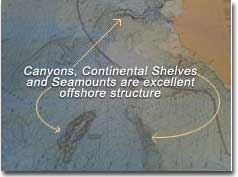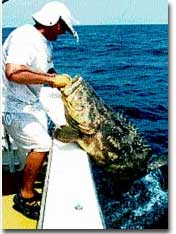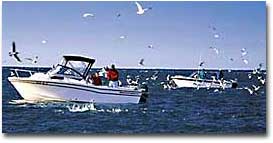Fishing Structure Part 3- Offshore
Fishing Structure Part 3- Offshore
By David HeinkeThe big advantage to fishing inshore and near shore water is that the forms of structure are more numerous and closer to the angler's port. However, not all species of fish reside in the water near land; if you want to pursue fish such as tuna, dorado, grouper, billfish and the like, heading anywhere from ten to fifty miles from shore is necessary. When you get that far away from land, the ocean or great lake can seem like a mighty large body of water, which it is of course. So how do you find fish in such a large area? Structure! First it is wise to determine the type of fish you desire to catch and then try to find the type of structure in which that fish is likely to be found. Bottom dwelling fish will most likely be found hanging around wrecks and artificial reefs, oil platforms and high relief bottom topography. Pelagic fish such as tuna and billfish will most likely be found where the food is located, mostly along temperature breaks, along the continental shelf, seamounts and canyons. Find the structure and you'll find the fish.  Offshore structure for the most part is similar to other types of structure found closer to land. Bottom contours that offer a break or relief from a flat nondescript terrain tide lines and areas of different temperature, offshore oil platforms and, of course, flotsam and jetsam are all excellent forms of fish holding structure. First, let's take a look at bottom features that might hold fish. Offshore structure for the most part is similar to other types of structure found closer to land. Bottom contours that offer a break or relief from a flat nondescript terrain tide lines and areas of different temperature, offshore oil platforms and, of course, flotsam and jetsam are all excellent forms of fish holding structure. First, let's take a look at bottom features that might hold fish. Areas that have a dramatic change in bottom elevation seem to be rich with life. There are many different factors that contribute to the abundance of fish, but mostly an abrupt change in elevation will result in current changes. Rich, nutrient-filled water from the depths is brought near the surface where sunlight can reach it. The water blooms to life with plankton, the base of marine life. Krill, squid and small marine animals feed on the plankton and larger fish in turn feed on the smaller species of life. A very experienced tuna fisherman friend of mine refers to these areas as "where the lines meet." Look for where the depth contour lines are grouped closely together. The closer the lines, the steeper the gradient. The further apart the lines are the flatter the area.  On the West Coast of North America, the above scenario is played out along the coastline. Salmon, Albacore tuna and swordfish in the northern waters while yellowfin tuna, marlin and sailfish thrive in the waters to the south. Depending on what part of the coast you're fishing, the continental shelf might be as close to shore as five miles, while in other places, areas of great depth change might occur twenty to thirty miles out. On the East Coast and the Gulf coast, the shelf is much further offshore and will require at least a twenty-mile run to access these waters. On the West Coast of North America, the above scenario is played out along the coastline. Salmon, Albacore tuna and swordfish in the northern waters while yellowfin tuna, marlin and sailfish thrive in the waters to the south. Depending on what part of the coast you're fishing, the continental shelf might be as close to shore as five miles, while in other places, areas of great depth change might occur twenty to thirty miles out. On the East Coast and the Gulf coast, the shelf is much further offshore and will require at least a twenty-mile run to access these waters. Further from shore, especially along the West Coast and Hawaii are areas where the tops of underwater mountains or seamounts reach near to the surface. These are natural areas of structure that will always hold fish. The closer the mount is to the surface the better. And, of course, offshore islands are excellent fishing zones. Along the Gulf coast and the East Coast, wreck fishing is very popular. Ships, wrecked either by the forces of Mother Nature or through the efforts of man, become havens for fish. Many times when a ship is sunk or when artificial reefs are formed by dumping concrete rubble, used military equipment and other hard objects into the water, within weeks, marine life has taken hold with baitfish and predators alike. Snappers, groupers, amberjack, dorado and more make up the usual catch when wreck fishing. Most wreck locations are available, for free, from the various state agencies governing the water you are fishing. The locations are usually given in latitude and longitude, so a GPS locator is essential to finding these fish havens. Once you are in the general location of the wreck, you will need a fish finder of sufficient resolution and depth capability to pinpoint the area you will want to fish. Most man-made wrecks and reefs are in areas that would not normally hold fish, so if you are not on the wreck, you're not on the fish. Once you have found the wrecks, make sure you mark your chart with notes on what the wreck looks like to help find it again in the future. Other areas that provide offshore structure are those where areas of different water temperatures meet. Tuna fishermen on both coasts know to look for warm core eddies that spin off from the various conveyor belt currents. The fish will usually be on the side where the water temperature is more to their liking, but not always. If you are fishing a temperature break and you are not getting any action, try fishing the other side, it might change your luck. Many times fish will move from an area of water they prefer to one that is not comfortable, but will do so to pursue food. Fishing can be red hot in these conditions, because the fish are only there to eat and eat they will! There are many fine sites available on the Internet where you can find up-to-date water temperature readings. NOAA provides some good sites and, best of all, they are free! Offshore oil platforms and buoys are excellent fish holding structures. Unfortunately the southern coast of California and the Gulf of Mexico are littered with these structures. Fortunately for the fisherman however, these provide structure in what would normally be a desert. You can always count on hooking several fish at each platform and you can make a day of just running from platform to platform in search of prey. Finally one of the most overlooked forms of offshore structure is anything you might find floating on the surface. I don't care whether it's the crew from Gilligan's Island on a rescue raft or a floating Styrofoam coffee cup, if you see anything floating on the surface, stop and cast. Sargasso weed, airplane wreckage, chunks of drift wood- you name it. The chance of a prowling dorado, cobia, or jack found lurking around is very high. Also, after you haul in that giant dorado that's hiding under Bill-Bob's long-lost Styrofoam cooler, make sure you haul in the cooler too. If you are running to another area and you see something floating, stop and take a look. Approach the flotsam quietly, then throw a cast to near the structure. Hold on because you never know what might hit your offering. If you are trolling, always make a few passes around any floating structure before moving on.  When I used to do a lot of offshore trolling, I would usually have one crewmember keep a constantly on the lookout with binoculars for either flotsam or diving birds. Of course if you ever find a flock of birds diving while off shore, you know by now what they are feeding on and why. If you don't check out any area with diving birds, then you must not want to catch fish! When I used to do a lot of offshore trolling, I would usually have one crewmember keep a constantly on the lookout with binoculars for either flotsam or diving birds. Of course if you ever find a flock of birds diving while off shore, you know by now what they are feeding on and why. If you don't check out any area with diving birds, then you must not want to catch fish! The bottom line to any type of fishing you might want to pursue is that fish will be found on and around structure. Remember, about ten percent of the water will hold about ninety percent of the fish, so find that ten percent and you'll be into fish. Study your charts, learn to read the water and keep an eye on the water temperature. If you find structure then you have found the fish and now its up to you to present your bait in an alluring manner to hook, play and then land your quarry. Until next time, Look for structure! This article is printed with permission from West Marine. Visit their website, http://www.westmarine.com for more boating supplies and information.
|
